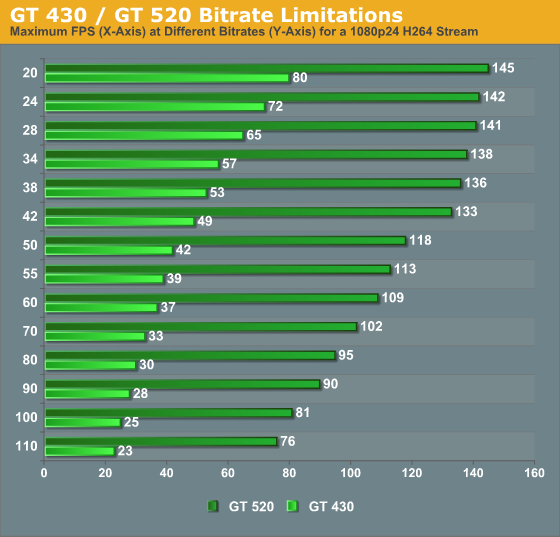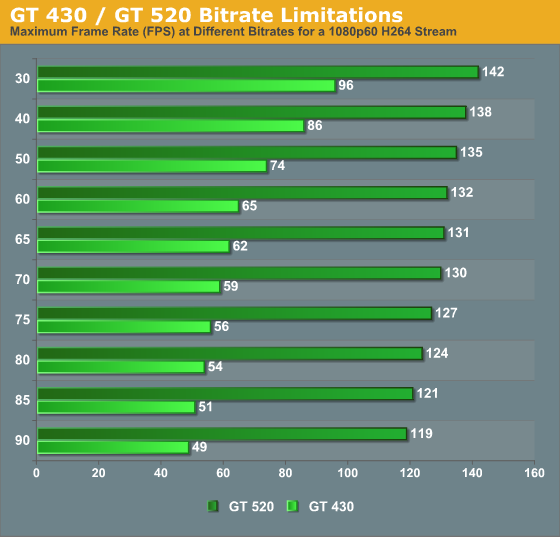Discrete HTPC GPU Shootout
by Ganesh T S on June 12, 2011 10:30 PM ESTIn the previous section, I mentioned about the bitrate limitations of the GT 430 when decoding 1080p H264 clips. NVIDIA confirmed that the GT 430 couldn't decode 60 fps videos at 80 Mbps. This piqued my curiosity and I tried out a few experiments to find out whether bitrate limitations exist for the usual 1080p24 videos on both the GT 430 and GT 520.
The DXVA Checker benchmark was repeated for all the bitrate testing files found in the NMT test files upto 110 Mbps.

We also created our own suite of bitrate testing streams at 1080p60. Running them through the DXVA Checker benchmark yielded the following results.

The results are presented in a bar chart above (A line chart would have made much more sense, but the outer values get placed only for bar charts in our graphing engine). For 1080p24 streams, we find that the GT 430 is unable to keep up with the real time decode frame rate requirements at 110 Mbps. For 1080p60 streams, the limit gets further reduced to somewhere between 65 and 70 Mbps. The GT 520 has no such issues.
The above testing is only of academic interest, since there is no real 1080p24 content at 110 Mbps. Even 3D Blu-rays max out around 60 Mbps (and that includes the audio stream!), so users shouldn't really be concerned about this bitrate limitation of the GT 430.
The GT 520's scores above are more interesting. Even the high end GPUs such as the 460 and 560 are unable to achieve that frame rate. The answer was buried in the README for the latest Linux drivers. The GT 520 is the first (and only GPU as of now) to support the VDPAU Feature Set D.
We asked NVIDIA about the changes in the new VDPAU feature set and what it meant for Windows users. They indicated that the new VPU was a faster version, also capable of decoding 4K x 2K videos. This means that the existing dual stream acceleration for 1080p videos has now been bumped up to quad stream acceleration.
Though the GPU can decode 4K videos, it is unfortunately not able to output it through HDMI. Despite the HDMI controller being advertised as HDMI 1.4a, it doesn't implement the 4K x 2K resolution part of the standard. The lack of HDMI sinks which accept that resolution is another matter, but that should get resolved in the next few years.
Despite the GT 520's advanced VPU engine, the lack of shaders limits its post processing capabilities. With all post processing options enabled, the GT 520's GPU load was always between 60 and 80%. The memory controller load (DRAM bandwidth usage) was between 20 and 40%. Despite the headroom apparently available, NVIDIA indicated that there weren't enough shaders available to implement the more advanced deinterlacing algorithms.










70 Comments
View All Comments
qwertymac93 - Monday, June 13, 2011 - link
What the heck are you talking about?velis - Monday, June 13, 2011 - link
A great review. Provides all the answers one could wish for and even gives some further hints.I sure hope you have something like this lined up for llano.
If I may suggest a couple or three things:
Perhaps you should also mention reclock - it will solve most 23.976 and similar problems... It's not like many will detect that the video is running 1/24000th faster. Plus it's insanely easy to use.
I understand you couldn't just post full blown images for space problems, but those thumbnails require too much work too. Is it possible to display a popup of sorts when one mouse-overs those thumbnails?
Also a vertical line showing 60FPS in those DXVA tests would be great :)
ganeshts - Tuesday, June 14, 2011 - link
I will pass on your request(s) to the person in charge of the graphing engine :)Salfalot - Monday, June 13, 2011 - link
What might have been a nice option is to see what sound levels the cards produced. Even it was only for the GT430 and the HD6570. I know that the decibels can differ between manufacturers but it would have been nice!For the rest a very nice detailed review between HTPC cards. I was deciding which card to buy so this helped a great deal! I was only looking between the HD6450 and the HD6570 but the GT430 is a better option than the HD6450.
nevcairiel - Monday, June 13, 2011 - link
HDMI Audio is purely digital, there is no diference based on what card you use.It depends on the audio decoder, and your receiver at the other end of the HDMI link, the HDMI sound card on those cards does not change the audio.
Salfalot - Monday, June 13, 2011 - link
I think I did not use the right word, as I meant the levels of decibel the fan of the cards produce and not the audio too and through speakers.All reviewed cards have a fan on them and since most of the HTPC setups are in the living room it would have been nice to know which of the cards are most silent.
ganeshts - Monday, June 13, 2011 - link
Though we considered cards with fans in this review, we made it a point to note that the same configuration (GPU model + DRAM bus width + operating frequencies) can be obtained with passive cooling from other vendors.For example, the 6570 has a passively cooled model from HIS with the same config and Zotac has a passively cooled 430 too. Other vendors have also demonstrated passively cooled models in Computex.
cjs150 - Monday, June 13, 2011 - link
Firstly, a truly informative article. Very high quality.The fact that none of AMD, Intel and Nvidia can lock onto to the correct frame rates is unforgiveable. It is not as though these frame rates have changed over the last 6 months. It should not be necessary to be an advanced HTPC user and delve into custom creation of frame rates.
I really hope that the representatives of AMD, Intel and NVidia are hanging their heads in shame at such basic errors - sadly I doubt they care.
Grasso789 - Monday, January 28, 2013 - link
The mistake is rather with Microsoft. Video playback speed should be adapted to the refresh rate of the grafx card. There is a software called Reclock doing that. Then, for example 23,996 Hz can be run with a monitor refresh rate of n times 24 Hz. (The same with audio, because bit-perfect transmission only works with synchronization.) In the end and for most sources, the RAMDAC needed only (multiples of) 24, 25 and 30 Hz. In any system, one of its parts should be the clock master, while the other parts serve.casteve - Monday, June 13, 2011 - link
Excellent review, Ganesh! Your HTPC insight/reviews have been missed.